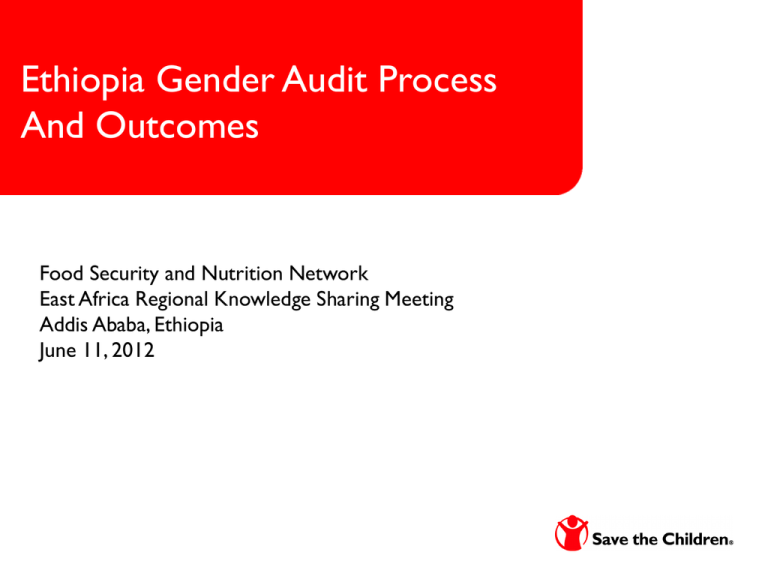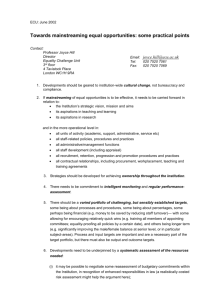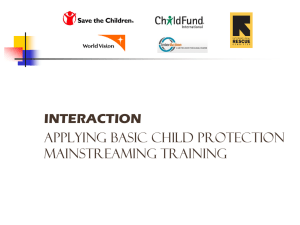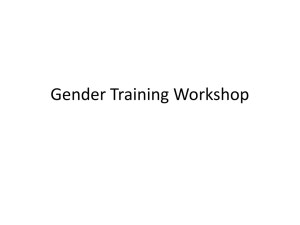Gender and Diversity Audit Process consisted of 5 main components
advertisement

Ethiopia Gender Audit Process And Outcomes Food Security and Nutrition Network East Africa Regional Knowledge Sharing Meeting Addis Ababa, Ethiopia June 11, 2012 1 Rational for looking at Gender Issues • Cutting across all social groups and sectors, gender inequality is the most persistent predictor of vulnerability and poverty everywhere. • Globally, it is a well know fact that supporting women and girls’ empowerment and promoting gender equality is central to achieving all human development goals. 2 Rational for doing a Gender Audit, Save the Children • Question on quality and quantity of gender and diversity in programming - Is programming addressing women and men and boys and girls practical needs and strategic interests ? • Only 20% of Save the Children Ethiopia staff are women. • Global Save the Children “Policy on Gender Equality” (2009) provides a good start. However, there was no action plan and the policy was not endorsed agency wide. 3 What is a participatory gender audit? It is a step-by- step organizational change process and tool based on a participatory methodology . It assesses the internal and external dimensions of an organization in terms of the level of gender equality with a diversity lens and mainstreaming of an organization. For example, Save the Children’s staff survey assessed staff perceptions of organizational and programming policies, programs, practices and structures. It promotes organizational learning on best ways to mainstream gender and diversity practically and effectively for maximizing impact on boys’ and girls’ live 4 Save the Children Audit Objectives 1. Create a facilitated process for learning on gender and diversity inclusion (GEDi) 2. building capacity to foster gender equality, inclusion and diversity; 3. Compare Save the Children to how other similar INGOs are working on GEDI in Ethiopia; 4. Provide roadmap for developing an organizationalwide GEDi strategy and action plan 5. Establish baseline data and benchmarks to assess progress over time; 5 Gender and Diversity Audit Process consisted of 5 main components: 1. 2. 3. 4. 5. Self-assessment questionnaire Focus group discussions Desk review of programming and institutional documentation Peer learning session with other INGOs Institutional action planning for policy 6 Organizational & Programming Audit Process Total staff sent questionnaires Total # completed Staff Sample representation Total analysed Representation by sex: Male Female =233 =131 =20% =121 =88 respondents or 72% =33 respondents or 27% This breakdown reflects current Male = 515/80% to Female=131/20% /Total Staff = 646 staff To ensure regional representation, the staff sample included representation from main office and sub-offices: Addis Ababa, Awassa, Nazereth, Liben, Dollo, Mekele, Dire Dawa and Bahir Dar. 7 Process, continued • 2 female focus group discussions (Addis & Nazareth) • 2 male focus group discussions (Addis & Nazareth) • 2 programming staff focus group discussions • 1 Human Resource Department focus group discussion • 1 focus group discussion with project partners • 2 one-to-one interviews with senior management • 1 Peer Action Learning Forum with 11 different INGOs working in Ethiopia (including 5 other Save the Children Members) 8 Process, scoring Using a 1-6 range scale, a 1 indicates a very low score in one of the dimensions whereas a 6 would indicate a very high and favourable score in a given dimension. For example: if the mean average for the series of questions in the questionnaire on “Gender and Diversity Policy” is 2.5 this may be read as: There is a policy being developed or in place but not implemented, the system is somewhat effective, dialogue on values or norms has begun, minimal training provided, leadership supportive but not proactive. 9 Survey Results Results, Political Will Role in SCI High level of political will and support at all levels of the organization to improve Save the Children’s track record in advancing gender equality and diversity. For example in area of equal opportunity in hiring – Most staff are very supportive of increasing representation of women and diversity of staff on staff including promotion of women to senior management positions. Scores were 4 and above. POLITICAL WILL (3.53) 11 Recommendations, for action Role inWill SCI Political Develop an organizational-wide gender and diversity policy and related action plan with SMART objectives and a means for measuring progress towards meeting policy commitments. All staff should be properly socialized and trained on the policy and action plan, particularly on how they pertain to their specific work. Review all organizational policies to ensure they are gender and diversity sensitive and have implementation plans. Priority should go to adding an annex with clear guidelines in the HR and Equal Employment Policy to integrate more proactive & innovative strategies to attract and retain women staff and promote women internally. 12 Results, Accountability Staff generally believed that the organization has accountability mechanisms in place. Survey respondents were very positive about gender and diversity sensitivity of human resource policies which brought the highest scores: Equal opportunity policy maternity and paternity policies Special allowances for women – i.e. Hardship Human Resource Policies commit the organization to maintaining a gender balanced and diverse staff to be representative of the communities in which it works. Affirmative action for women is a priority until gender balance is reached. ACCOUNTABILITY=3.55 13 Recommendations, Accountability Include gender and diversity awareness in job descriptions and job performance criteria Allocate human and financial resources for new Gender and Diversity Policy and Action Plan (i.e. gender expertise and budget) 14 Results, Organizational Culture Staff were generally positive about the work culture at Save the Children in terms of gender and diversity sensitivity However, Gender Differences in experience and perceptions - Men’s perceptions of the organizational environment to promote gender and diversity is much more positive than for women staff. Some male respondents think current HR policies and practices favour women. (For example – 33% of male staff think gender is fully mandated by the organization as compared to only 17% for females. ) Score ranged from lowest 2.5 to highest 5.51 ORGANIZATIONAL CULTURE = 4.4 15 Recommendations, Organizational Culture Develop an inclusive and collaborative gender and diversity mainstreaming approach that communicates the benefits of gender transformation for women and men in order to counteract any resistance from inside and outside the organization to advancing gender equality and diversity. Organize ongoing and specific gender and diversity awareness training and peer action learning forums using a gendertransformative inclusive approach that engages women and men staff Develop immediate incentive system to reward staff for good performance in promoting gender and diversity. 16 Results, Technical Capacity Results indicated that most staff feel there is minimal training in gender and diversity. Study found a lack of clear program guidelines and staff capacity to integrate gender and diversity leading to inconsistent and ad hoc integration of GEDI within and between projects. Many projects used gender blind language and content ignoring the fact that women, men, boys and girls have different needs, interests, positions of power and experiences which if left unaccounted for, can do harm rather than bring positive change to all equitably. Scores ranged between : lowest score (2.94) and highest score was (5.39) TECHNICAL CAPACITY=3.4 17 Recommendations, Technical Capacity Priority must be given to training and learning needs of program staff to build up their understanding and practical skills on how to integrate gender and diversity issues into their daily work. Specifically in programming; Save the Children must develop program/project guidelines and related training to ensure gender and diversity is consistently integrated into all projects and programs from design to measuring impact on women/girls’ empowerment, gender relations and equality. Develop project management toolkit for GEDI mainstreaming with general guidelines for all programming and specific ones for different program areas. 18 Top 3 Obstacles to gender & diversity mainstreaming into project management cycle • 1) Lack of staff competency for gender and diversity programming • 2) lack of financial resources for gender and diversity programming • 3) lack of gender analysis tools 19 4 Top Learning Needs 1) Gender planning and strategies development 2) Gender sensitive project proposals 3) Gender sensitive Monitoring and Evaluation 4) Promoting gender with partners 20 Ongoing work 1. Hiring Director of Program Quality, leading the Gender Champions Task Group 2. Detailed Implementation plan For example - WASH project • gender mainstreaming guideline/checklist • national manual on gender mainstreaming • gender sensitive monitoring checklist • all WASH team is already received three days training on Gender mainstreaming. 3. Continued program learning forums with partners 4. GEDi Training template 21


![Gender mainstreaming in higher education [PPTX 1.25MB]](http://s3.studylib.net/store/data/009261055_1-dfa19b70fcd91637c7a1dbd1bc939bd3-300x300.png)



